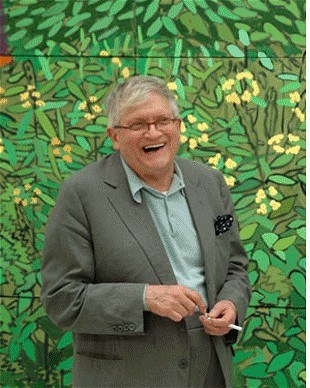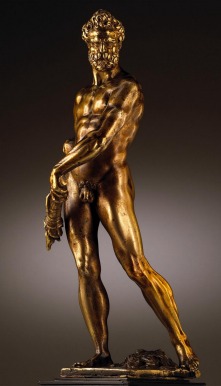I can’t say I didn’t enjoy reading David Hockney’s recent comments on the art world, specifically those aimed at Damien Hirst.
 As The Guardian reported it, Hockney used a small note on the posters for his coming exhibition at the Royal Academy –Â “All the works here were made by the artist himself, personally” — to send a dart at the “creator” [my quotation marks]Â of the diamond-encrusted skull (For the Love of God), which is among so many other works made by others but presumably conceived by Hirst. Hirst will have a show at the Tate beginning in April, filled with art made by his assistants.
As The Guardian reported it, Hockney used a small note on the posters for his coming exhibition at the Royal Academy –Â “All the works here were made by the artist himself, personally” — to send a dart at the “creator” [my quotation marks]Â of the diamond-encrusted skull (For the Love of God), which is among so many other works made by others but presumably conceived by Hirst. Hirst will have a show at the Tate beginning in April, filled with art made by his assistants.
Hockney also said, “I used to point out, at art school you can teach the craft; it’s the poetry you can’t teach. But now they try to teach the poetry and not the craft.”
Interpreted by Richard Dorment of the Daily Telegraph, Hockney is “saying that students used to be taught how to draw perfectly at the expense of their individuality. Now scores of students graduate from art colleges believing that everything they do or touch or say can be labelled a work of art but they couldn’t draw a rabbit if you held a gun to their heads.” (Dorment goes on to say that he doesn’t care how a piece is made, as long as it has the poetry.)
This conversation reminded me of an interview I did about 15 months ago with Ndidi Ekubia, a British Nigerian silversmith whose work was included in The Global Africa Project at the Museum of Art and Design in 2010. She’d just returned from a day at the Frieze Art Fair in London when we talked, and she couldn’t help remarking, she said, on how poorly made so many of the art works on view were. Nevermind their “poetry” (which I inferred she was not fond of, for the most part), she was dismayed by their craft. She felt that makers of what today is called “design,” were more careful about quality than makers of “art.”
Of course, that’s not all that is wrong with some art of today. Another conversation I had recently has also come to mind — with a museum director, who must remain nameless because we were speaking on background. S/he was so very disappointed by the show of Dale Chihuly at the Museum of Fine Arts in Boston, because s/he had been a proponent of his decades ago — but now feels the work is bereft of ideas.
The art world is not the only place these issues have surfaced. (‘Twas ever thus?) In his recent blog post on Brainstorm, David Barash discusses the dearth of the “Novel of Ideas,” which he prefers to mere stories. As he notes, “Many of the towering works of 19th century literature (from Hugo and Zola to Dostoyevsky and Turgenev), which to my mind represent a novelistic high point, seem explicitly concerned with making a point or generating intellectual debate, and not simply hoping to entertain or just to portray accurately a ‘slice of life.’ ”
I suppose the best art has poetry, craft and ideas, and the people who make that kind of art are the artists that will be remembered for their work. Will either Hockney or Hirst qualify?
David Hockney RA — A Bigger Picture opens on Jan. 21.
Photo Credit: Courtesy of The Guardian

 Headlined The New Allure of Old Master Sculpture, it features an area of the art market that is far too rarely noticed. Yes, you see a piece mentioning Renaissance bronzes every now and then, but that’s most of the coverage.
Headlined The New Allure of Old Master Sculpture, it features an area of the art market that is far too rarely noticed. Yes, you see a piece mentioning Renaissance bronzes every now and then, but that’s most of the coverage. Here’s the
Here’s the